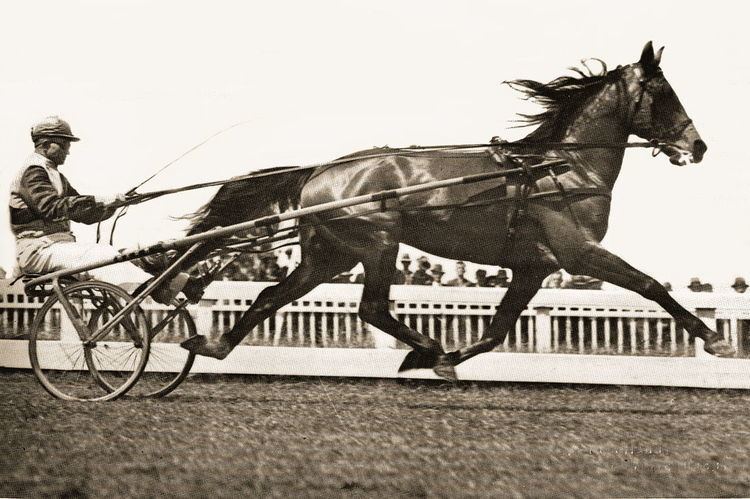 | ||
Harness racing in New Zealand is more often called trotting in the "old school" rather than the more fashionable name of "harness racing". The sport is long standing with events being held as early as 1864. In New Zealand trotting as a sport involves both pacing and trotting competitions for Standardbred racehorses.
Contents
History
Trotting races were held as part of the programme of some of the galloping meetings in the Otago Southland area as early as 1864. The first totalisators were introduced about this time. They faced opposition from a curious alliance of bookmakers and anti-gambling factions but were approved by the Clubs and licensed by the Colonial Secretary. The first trotting race on a racecourse in Canterbury, in 1875, before the totalisator was introduced, the stake was only about a "tenner" (£10), but the match created a lot of interest. About 1880, Lower Heathcote Racing Club was founded, supporting gallops, but added trotting events to its programme, giving smaller stakes. Some years later the club discontinued gallops and became the Lower Heathcote Trotting Club, which gave stakes ranging from £15 to £35.
The New South Wales bred, Lawn Derby, racing un-hoppled, was the first pacer to break the two-minute barrier in Australia or New Zealand when he recorded 1:59.4 at the Addington track in New Zealand in 1938.
From these early stages, the sport has developed with top races and top horses from then right up to the present day.
Major races
In New Zealand the richest and most important race is the New Zealand Trotting Cup, run for older pacers in November at Addington. Other major races include the Auckland Trotting Cup as well as the Noel J Taylor Memorial Mile and the New Zealand Messenger Championship for four-year-olds. There are also the New Zealand Derby and the Great Northern Derby for three-year-olds, and the Dominion Handicap and Rowe Cup for trotters. The Harness Jewels raceday (the end-of year championships for two-, three- and four-year-olds) takes place in late May or early June
A marquee event is the annual series which takes place between New Zealand and Australia called the Inter Dominion. The series, which includes a pacing series and a trotting series, is held yearly and rotated around the Australian State Controlling Bodies and once every four years the Inter Dominion Championships are held in New Zealand.
Racing rules
New Zealand racing differs from North American racing in that metric distances are used, generally above the equivalent of one mile and horses are classed by how many wins they have. Another large difference is that in New Zealand racing the leader does not have to hand up the lead to any horse that challenges, often leaving a horse parked outside the leader in the "death seat", "the death", or "facing the breeze", as this horse covers more ground than the leader. New Zealand racing generally has more horses in each race, a field of 12 or 13 is not uncommon. This generally means that with the smaller tracks a "three wide train" starts as the field gets the bell at signal their final lap. There is a system of an 'open lane' or 'passing lane' ('sprint lane' in Australia). These lanes do not operate on all tracks and have been a point of argument between many industry participants. Many horses are able to easily "cross the Tasman" to Australia, as the rules are similar.
United States and Canada
The association with trotting in New Zealand and the United States has always been strong, with much of the breeding stock coming from America. Particularly in the 1950s and 1960s, New Zealand horses competed in both Canada and the United States. The first New Zealand horse to be raced in America by a New Zealander was the trotter Vodka, the winner of the 1953 Dominion Handicap. He was taken there in 1956 by his owner, J. S. Shaw, won 11 races and was later leased to American interests.
In 1960 Caduceus was the first New Zealand pacer to compete in the Yonkers International Series with his trainer-driver, J. D. Litten. Despite his nine years, Caduceus showed he was the equal of the top American horses, winning the last race of the series, only to be disqualified. He also was leased to American interests and at 10 years of age was still winning races.
False Step was driven in the Yonkers International series during the 1960–61 season by his trainer C C Devine. False Step's performances showed he was one of the greatest pacers in the world. He beat the acknowledged American champion, Adios Butler, in a 1½ mile race. He was sold in America for 115,000 dollars, the fifth highest price paid for a pacer in the United States.
Arania also entered the series with False Step. She did not do well, but after being leased won several races and proved she was able to race with the best in America, and in fact created a record of 1 min 57 sec for 1 mile in the Lexington Red Mile.
In 1964, Cardigan Bay was to travel to America with reinsman Stanley Dancer, who paid 100,000 dollars for the horse. Cardigan Bay was already an established racehorse in New Zealand, having won the 1963 New Zealand Trotting Cup and other top races in Australia and New Zealand. He went on to win over a million dollars in the United States, the first harness horse ever to do so.
